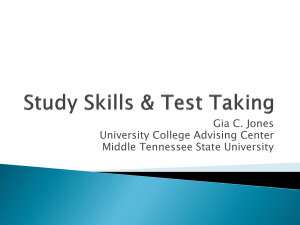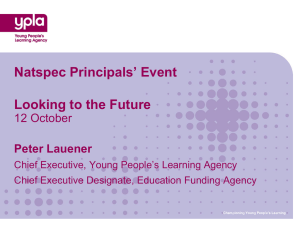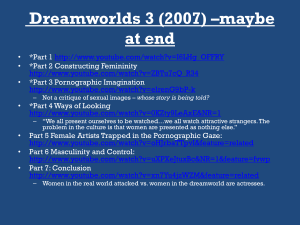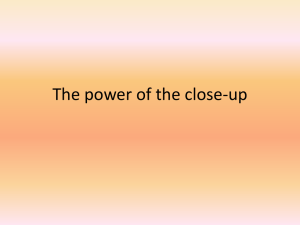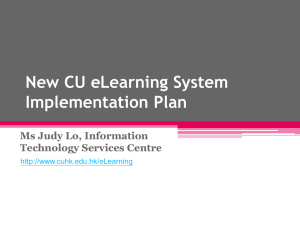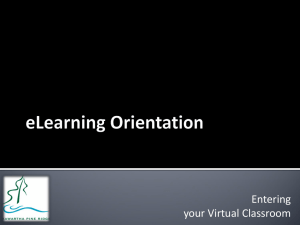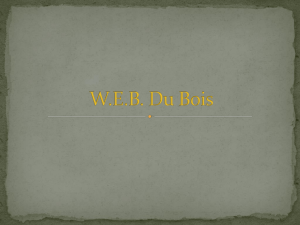Assessing Eye-Tracking Technology for Learning
advertisement
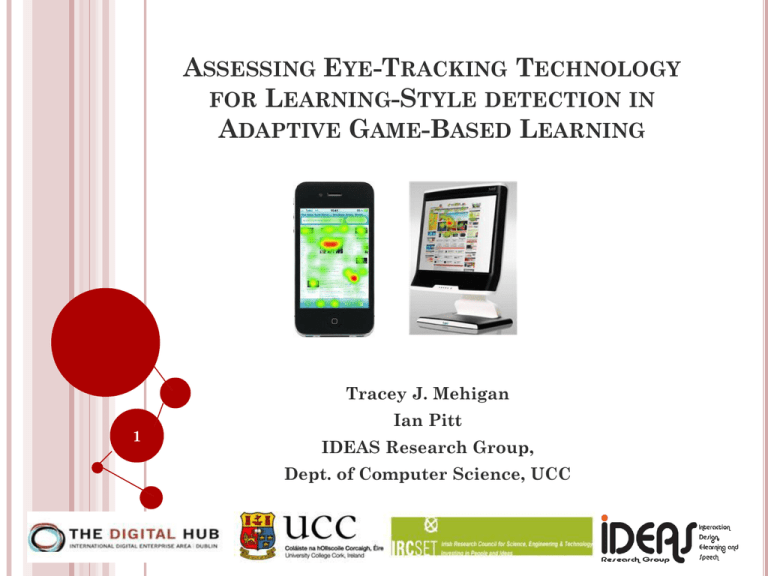
ASSESSING EYE-TRACKING TECHNOLOGY FOR LEARNING-STYLE DETECTION IN ADAPTIVE GAME-BASED LEARNING Tracey J. Mehigan 1 Ian Pitt IDEAS Research Group, Dept. of Computer Science, UCC INTRODUCTION Background Adaptive eLearning systems Learning-styles Felder-Silverman LSM FSILS Questionnaire Eye-tracking & eye-tracking technologies Detecting Global / Sequential learners Detecting Visual / Verbal learners Potential for Mobile GBL Eye-tracking for GBL in mobile environments 2 BACKGROUND Measurement of learning-styles facilitates the provision of adaptive content to specific learner needs Data traditionally gathered using questionnaires Recently, user interaction with learning systems has proven a valuable method of data gathering for learning-styles Eye-tracking technology could provide a better method of user data collection for learning-style analysis 3 ADAPTIVE LEARNING SYSTEMS User interaction with learning systems has proven a valuable method of data gathering for learning-styles A number of studies in recent years have looked at the inference of learning-styles using the FelderSilverman model Bayesian Networks (García et al) Behaviour Patterns (Graf and Kinshuk) Feed Forward Neural Networks (Villaverde et al) Mouse movement patterns (Spada et al) Accelerometer Interaction (Mehigan et al) 4 LEARNING-STYLES & PERSONALITY MODELS One of the most analysed cognitive features in the development of adaptive systems in eLearning environments Learning-style models classify students according to where they fit on a number of scales depending upon how they process and receive information Learning Style & Personality Models Myer-Briggs Model The Big Five Model Felder-Silverman LSM 5 FELDER-SILVERMAN LSM The Felder-Silverman Learning-Style Model (Felder & Silverman 1988) is a widely employed model for inferring individual learning-styles Based on four learning dimensions: Active /Reflective Sensitive /Intuitive Global / Sequential Visual / Verbal 6 LEARNING STYLES QUESTIONNAIRE HTTP://WWW.ENGR.NCSU.EDU/LEARNINGSTYLES/ILSWEB.HTML 7 EYE –TRACKING “Eye-tracking works by reflecting invisible infrared light onto an eye, recording the reflection pattern with a sensor system, and then calculating the exact point of gaze using a geometrical model. Once the point of gaze is determined, it can be visualized and shown on a computer monitor” (Tobii.com) 8 EYE-TRACKING RESEARCH Eye tracking technology is widely used in many disciplines Commerce, learning difficulties, etc. Studies have been conducted based on HCI, visual cognition and web accessibility Research has explored saccade velocity, blink rate and the degree of eyelid openness for determination of user’s tiredness level This can complement other information gained by the system through user behavioural patterns Few examples of eye-tracking-based work in eLearning and subsequently, game based learning However, researchers at a UK university are developing computer games which can be controlled by eye movements 9 TOBII EYE-TRACKING TECHNOLOGY Calibrate for the user’s vision System records the user’s eye movements while s/he observes the test scene(s) Analyse the data on individual and / or group level Gaze plots Heat maps Statistics Can be based on Areas of Interest (AOI’s) 10 DETECTING GLOBAL / SEQUENTIAL LEARNERS Sequential learners would show a slower vertical speed of eye movement between fixation points and a longer focus time than their Global counterparts 10 Participants selected from Dept of Computer Science UCC – reflecting a balanced sample of Global and Sequential learners 2 Screens Presented to the User A Learning Screen A Task Screen To ensure that the user gaze is following the screen content and not the cursor arrow the mouse is only used to move between screens. 11 GLOBAL & SEQUENTIAL LEARNERS GAZE PATTERNS & HEAT MAPS Global Sequential 12 DETECTING VISUAL & VERBAL LEARNERS Visual learners (as defined in terms of the FelderSilverman LSM) will exhibit longer total time (fixation) duration on visual learning content (images/graphics) Verbal learners will exhibit longer total time (fixation) duration on textual learning content 10 Participants selected from Dept of Computer Science UCC – reflecting a balanced sample of Visual and Verbal learners 2 Screens Presented to the User A learning screen A task screen To ensure that the user gaze is following the screen content and not the cursor arrow the mouse is only used to move between screens. 13 VISUAL & VERBAL LEARNERS GAZE PATTERNS & HEAT MAPS Visual Verbal 14 MOBILE LEARNING Mobile learning decreases limitation of traditional learning systems through the mobility of portable devices The incorporation of mobile devices provides an opportunity for ubiquity and collaboration in education The importance of the mobile phone to teenage identity and the development of social friendship networks facilitates incorporation of mLearning Mobile devices could be used to encourage young people to learn in a beneficial way 15 MOBILE GBL Mobile learning decreases limitation of learning location with the mobility of general portable devices Mobile GBL is usually Situated and Ubiquitous “We see a potential move away from immersive, game based learning, represented in traditional eLearning simulation systems, toward the advancement of situated mLearning environments” (Dede) Game based learning can also improve learning in specialist areas where students become engaged in a situated learning environment which occurs within the game (Williamson et al ) Mobile GBL can also be incorporated in blended and other learning environments 16 1 6 EYE-TRACKING FOR MOBILE GBL Potential to track user learning-styles through avatar movement via eye-based interaction The provision of adaptive systems based on the Felder-Silverman model could potentially offer students increased motivation to learn through personalised content Felder-Silverman’s model provides matching teaching-styles to each learning-styles and therefore content can be specifically tailored to the needs of each individual learner 17 1 7 EYE-TRACKING MOBILE GBL ENVIRONMENTS Eye-trackers are becoming smaller and less cumbersome, potentially offering a new method of mobile device interaction Recently ‘Gaze Gesturing’ has emerged as a means of controlling device interaction (Drewes et al) Tobii ‘Glasses’ offer the next generation of mobile eye-tracker Recent work conducted by Miluzzo et al facilitates the use of forward facing mobile device cameras for eye-tracing purposes 18 CONCLUSION Background Adaptive eLearning systems Learning-styles Felder-Silverman LSM FSILS Questionnaire Eye-tracking & eye-tracking technologies Detecting Global / Sequential learners Detecting Visual / Verbal learners Potential for Mobile GBL Eye-tracking for GBL in mobile environments 19 QUESTIONS?? COMMENTS!! 20
